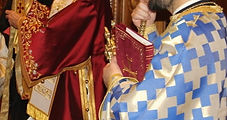EASTERN ORTHODOX CLERGY VESTMENTS
Materials & Colors



.jpeg)
Materials
While the Byzantine tradition of Christianity was able to continue under the occupation of the Ottoman empire, the old tradition of church art gradually weakened in the 16th and 17th centuries (Riefstal 1932, 359). However, commercial exchange with Italian merchants is thought to have brought a degree of artistic influence; vestments from this period may have been constructed using Italian materials (Riefstal 1932, 359). While the specific materials used to make vestments are not overly important, preference is given to organic materials (Kalaitzis 2023). They are typically constructed out of silk or linen, and the embroidery ornamenting them is made up of metal threads, including gold and silver (Riefstah 1932, 360).
Colors

Image: Archbishop and bishop on the feast day of the Annunciation (Lambriniadis 2023b)
The specific imagery, patterns, and garments worn by clergy can be distinct among different ethnic groups (McGuckin 2011, 622-3). In fact, vestments provide an example of Orthodoxy's adaptability to various ethnic cultures, given that colors can be chosen to best suit the symbolism of the locals; for example, a priest in Japan may choose not to wear white vestments to a funeral, since it is associated with mourning (instead of resurrection) in Japanese culture (Kalaitzis, 2023). Since this website focuses on Greek Orthodoxy, the identified colors are used with particular symbolic meaning in traditional Byzantine style, even though vestments throughout the empire were not always homogenous (Kalaitzis, 2023). Colors are correlated with important church figures, feast days, and aspects of divinity. According to Kalaitzis (2023), these specific color associations include:
-
Blue: associated with the Virgin Mary
-
Green: associated with celebrations of the Holy Cross (the wood of life, from trees)
-
Purple & black: associated with the week days during the fasting period of Great Lent, mourning (originally burgundy in Byzantine times)
-
White: symbolizes the grace of God, light, and resurrection (worn by the priest for funerals, on Sundays, and Easter); the base robe (or "stichari") of a priest's vestment is always white to carry this symbolism
-
Gold: symbolizes the power, glory, and purity of the Holy Trinity (worn on major feasts such as Pentecost and Christmas)
Other colors that can be featured on vestments include brown, yellow, and apricot (Woodfin 2012, 330).
Embroidery

Woodfin (2012) writes that vestments allow their wearers to become liturgical “microcosms” (101), given that the themes of the embroidery on the vestments are timed to coincide with the cycle of feasts depicted in the iconography. One way that the clergy’s role as an integral part of liturgical activities (such as the preparation and receiving of the Eucharist) is solidified is through the depictions on the cuffs (epimanikia) of the vestments, which transfer the scenes depicted on the icons of the church's walls onto the body of the clergy (Woodfin 2012, 101). The transference of these scenes emphasizes Christ's role as the "true minister of the sacrament" by making His invisible presence materially visible (Woodfin 2012, 101). Common images that are featured on vestment embroidery include crosses, angels, saints, the Virgin Mary, Christ, and the letters IC, XC, NI, and KA (standing for the Greek Iesous Christos Nika, or "Jesus Christ Victorious"; Riefstahl 1932, 364-5).
Image: Woodfin 2012, 101